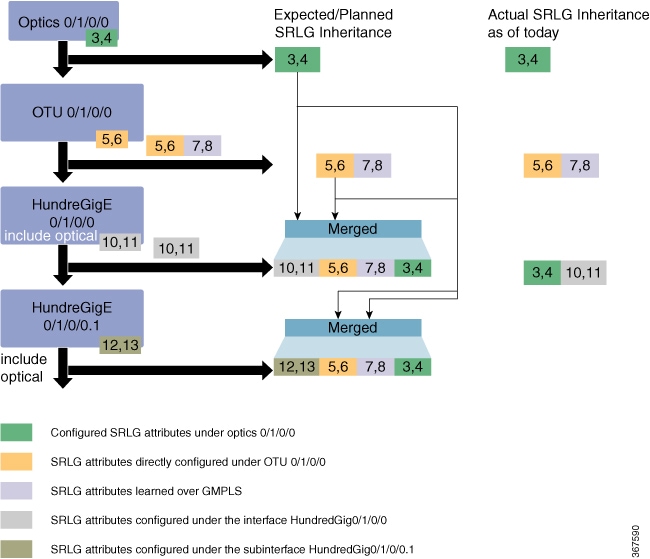To provide better protection at L2 layer, the SRLG configured on OTN layer needs to be propagated to the Ethernet Terminated
Interface. SRLG Announce feature enables to fetch SRLG values from all traversed TE-Links, summarize and announce them to
the ethernet terminated interface at head and tail nodes.
Perform following
procedure to enable SRLG announce on Ethernet Terminated ODU on headend node.
SRLG announce can be enabled on both headend and tailend.
Enabling SRLG
Announce on Ethernet Terminated ODU
The following
example shows how to enable SRLG Announce on ethernet terminated ODU using
Cisco IOS XR commands:
RP/0/RP0:hostname# configure
RP/0/RP0:hostname(config)# mpls traffic-eng
RP/0/RP0:hostname(config-mpls-te)# gmpls optical-nni
RP/0/RP0:hostname(config-te-gmpls-nni)# controller odu-group-te 10
RP/0/RP0:hostname(config-te-gmpls-tun-0xa)# signalled-bandwidth ODU2
RP/0/RP0:hostname(config-te-gmpls-tun-0xa)# static-uni local-termination interface-name TenGigE0/1/0/0/100 remote-termination unnumbered 32
RP/0/RP0:hostname(config-te-gmpls-tun-0xa)# destination ipv4 unnumbered 10.77.132.185 interface-if index 19
RP/0/RP0:hostname(config-te-gmpls-tun-0xa)# announce-srlg
RP/0/RP0:hostname(config-te-gmpls-tun-0xa)# path-option 1 dynamic protected-by none lockdown
To verify the above configuration use the following show command:
RP/0/RP0:hostname# show mpls tr tunnels detail
Name: Odu-Group-Te11 Destination: 10.77.132.185 Ifhandle:0x82001e4
Signalled-Name: 3M_otn11
Status:
Admin: up Oper: up Path: valid Signalling: connected
path option 1, (LOCKDOWN) type dynamic (Basis for Current, path weight 1)
Protected-by PO index: none
Reroute pending (DROP)
Bandwidth Requested: 10037273 kbps CT0
Creation Time: Thu Oct 5 08:59:53 2017 (00:45:09 ago)
Config Parameters:
Bandwidth: ODU2
Priority: 24 0 Affinity: 0x0/0xffff
Metric Type: TE (default)
Path Selection:
Tiebreaker: Min-fill (default)
Hop-limit: disabled
Cost-limit: disabled
Path-invalidation timeout: 10000 msec (default), Action: Tear (default)
AutoRoute: disabled LockDown: enabled Policy class: not set
Forward class: 0 (default)
Forwarding-Adjacency: disabled
Autoroute Destinations: 0
Loadshare: 0 equal loadshares
Auto-bw: disabled
Fast Reroute: Disabled, Protection Desired: None
BFD Fast Detection: Disabled
Reoptimization after affinity failure: Enabled
Soft Preemption: Disabled
SNMP Index: 72
Binding SID: None
Static-uni Info:
Locally Terminated Interface Name: TenGigE0_1_0_0_200 Ifhandle: 0x82001fc
Local Termination Type: Ether
State: Terminated up since Thu Oct 5 08:59:54 2017
SRLG Values: 2, 7, 8, 20, 21, 33,
Remote termination Interface: 0.0.0.0 [42]
Egress Client Port: 0.0.0.0 [42]
Working Homepath ERO:
Status: Down
Explicit Route:
Diversity Info: None
History:
Tunnel has been up for: 00:45:04 (since Thu Oct 05 08:59:58 UTC 2017)
Current LSP:
Uptime: 00:45:08 (since Thu Oct 05 08:59:54 UTC 2017)
Current LSP Info:
Instance: 302, Signaling Area: OSPF OTN area 0
Uptime: 00:45:08 (since Thu Oct 05 08:59:54 UTC 2017), Signaling State: Up, Oper State: Up
G-PID: Gfp_F Generic Framing Procedure-Framed (54)
XC Id: 0
State: Connected
Uptime: Thu Oct 5 08:59:54 2017
Egress Interface: OTU40/1/0/0 (State:Up Ifhandle:0x8a0020c)
Egress Controller: ODU40_1_0_0 (State:Up Ifhandle:0x8a00214)
Egress Sub Controller: ODU20_1_0_0_42 (State:Up, Ifhandle:0x82001ec)
Path Ingress label: TPN: 4 BitMap Len: 80 BitMap: 25:32
Resv Egress label: TPN: 4 BitMap Len: 80 BitMap: 25:32
Router-IDs: local 10.77.132.187
downstream 10.77.132.185
Soft Preemption: None
SRLGs: mandatory collection
Path Info:
Outgoing:
Explicit Route:
Strict, 10.77.132.185(19)
Strict, 10.77.132.185
Strict, 10.77.132.185(42)
Record Route: Empty
Tspec: signal_type ODU2 Bitrate 0kbps NVC 0 MT 1
Session Attributes: Local Prot: Not Set, Node Prot: Not Set, BW Prot: Not Set
Soft Preemption Desired: Not Set
Path Protection Info:
SNC Mode:SNC-N TCM id:Not used Type:Bi-directional APS
Path Protection Profile Type: 1+0
Bits S:0 P:0 N:0 O:0
Timeout WTR:0 milliseconds HoldOff:0 milliseconds
Resv Info:
Record Route:
IPv4 10.77.132.185, flags 0x20 (Node-ID)
Label Label TPN: 4 BitMap Len: 80 BitMap: 25:32 , flags 0x1
Unnumbered 10.77.132.185 (19), flags 0x0
Label Label TPN: 4 BitMap Len: 80 BitMap: 25:32 , flags 0x1
Fspec: signal_type ODU2 Bitrate 0kbps NVC 0 MT 1
Persistent Forwarding Statistics:
Out Bytes: 0
Out Packets: 0
Displayed 2 (of 2) heads, 0 (of 0) midpoints, 0 (of 0) tails
Displayed 2 up, 0 down, 0 recovering, 0 recovered heads

 Feedback
Feedback